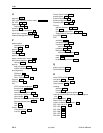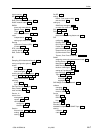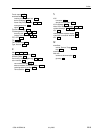
Index
IN-2
9783-A2-GB20-00
July 2000
Concord’s Network Health, 1-1
compatibility, 10-1
Configuration
Auto, Active, 6-14
displaying and changing options, 3-4
FTP transfer rate, 1-8
menu, 3-2
menu/branch, 2-4
option areas, 3-3
option tables, 4-7
saving options, 3-6
tables, 3-3
configuring
added SLV units/elements, 10-4
ATM options, 4-18
DLCI records manually, 4-19
frame relay options, 4-16
network interface, 4-13
SLV options, 4-10
System options, 4-7
the system, 3-2
Connectivity, test, 8-20
Control
keys, 2-6
lead descriptions, 6-6
Leads, Ignore, 4-43
Leads and LEDs, 6-3
menu/branch, 2-4
controlling
asynchronous terminal access, 5-2
external device access, 5-4
FTP access, 5-4
SNMP access, 5-8
Telnet access, 5-4
conversation elements, 10-3
CRC, 6-31
creating
a login, 5-11
new PVC connections/management links, 3-5
crossover EIA-232 cable, C-4
CTS
down, 8-7
down to Port Device, 6-14
current software revision, 6-2
D
Data
Delivery Ratio (DDR), 1-10
Link Control Identifier (DLCI), 4-30
Port, physical options, 4-14
port connector pin assignments, C-6
Rate (Kbps), 4-42
selection criteria, 2-1
uploading SLV and packet capture, 7-6
Date & Time setting, 4-6
DDR, 1-10
DE, Set, 4-29
Default IP Destination, 4-26
Delete key, 2-6
deleting a login, 5-12
Destination, 4-38
Default IP, 4-26
DLCI, 4-23
EDLCI, 4-23
Link, 4-23
Device
messages, 6-7
troubleshooting problems, 8-11
Dial-In Access, 4-46
disabling, SNMP access, 5-8
Discard Eligible (DE), 4-29
Disconnect, Time (Minutes), 4-34, 4-44
discovering elements/DLCIs, 10-3
displaying
configuration options, 3-4
identity information, 6-2
LEDs and control leads, 6-3
DLCI, 4-30
Destination, 4-23
Down, 6-14, 8-7
on SLV Timeout, 4-10
Number, 4-19
Priority, 4-21
Records, 4-19
Source, 4-22
statistics, 6-28
Traps on Interfaces, 4-39
Type, 4-20
downloading
determining when completed, 7-5
guidelines for, 7-2
MIBs and SNMP traps, B-2
software, 7-4


















